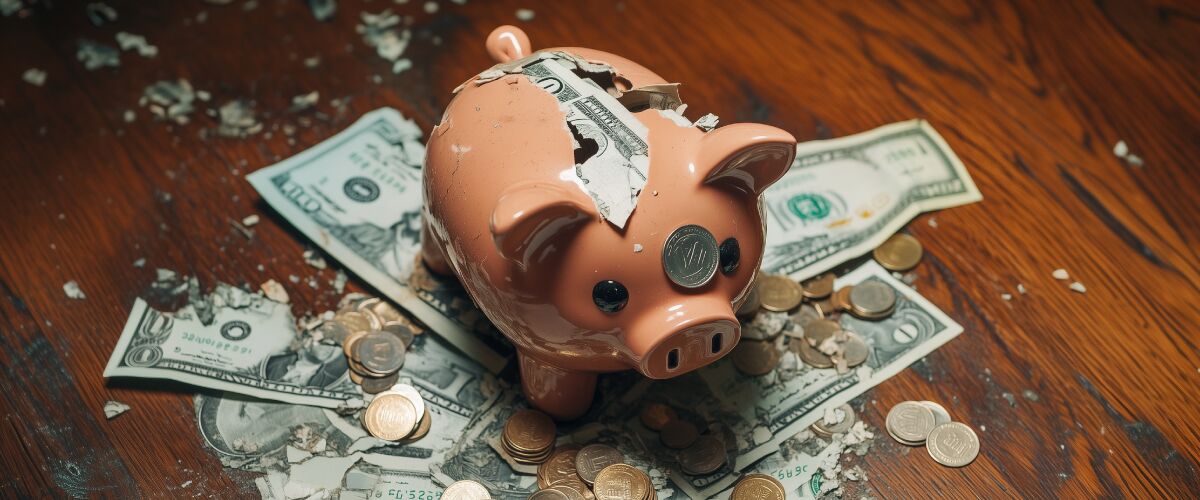Inflation Hits New Highs: Are We Worse Off Than the 1980s?
Earlier in April 2022, the Labor Department announced yet another month of inflation worse than at any time since the 1980s. The March Consumer Price Index (CPI) showed inflation increasing at an annual rate of 8.5%, up from 7.9% in February.
Who’s to Blame for Inflation?
Depending on who you talk to, inflation can be blamed on greedy corporations, greedy employees, or even consumers hoarding goods in the expectation that prices will rise even higher. Then, COVID-related supply chain disruptions continue. Energy and food shortages from Western sanctions on Russia after its February 2022 invasion of Ukraine have made them worse.
All these factors have worsened inflation. But, they are not its main causes. It’s not businesses, employees, consumers, or supply chain issues. As we’ve pointed out before, economists define inflation as an increase in the money supply.
What Really Drives Inflation?
A working definition of the term “money supply” comes from the Mises Institute:
Cash + demand deposits with commercial banks and thrift institutions + government deposits with banks and the central bank.
Thus, when the Federal Reserve acts as it did in the early stages of the COVID pandemic to create trillions of dollars out of thin air, that action represents an increase in the money supply. And when Congress borrows trillions of dollars to send stimulus checks to all but the wealthiest Americans, as it did three times during the pandemic, that also represents an increase in the money supply.
Viewed from this perspective, inflation appears inevitable. We have expressed that viewpoint unsparingly ever since the pandemic began.
Is Inflation 2022 Worse Than the 1980s?
But could today’s inflation actually be worse than the 1980s? We believe that it is.
If you’re old enough to remember that time, you’ll recall soaring oil prices, followed by rapidly rising prices for everything else as the impact of higher energy costs percolated through the economy.
But there are two key differences between then and now:
-
- In the 1970s and early 1980s, the CPI measured a largely fixed basket of goods and services, leaving less room for manipulation. In 1980, for instance, inflation reached 13.5%. That number wasn’t subject to hedonic adjustments as the CPI is today. The theory behind hedonic adjustments is that as the quality of goods or services improves, their effective cost decreases, even if consumers have no opportunity to buy those goods or services at a lower price.
- For example, a television that cost $1,000 in 1996 should now cost $22 according to the hedonically adjusted CPI. This shows how these adjustments can significantly alter the perception of inflation, making it seem lower than what consumers actually experience.
- Indeed, if inflation were measured the same way today as it was in 1980, the CPI would be growing at 17% annually. This chart from Shadowstats shows you the difference. The chart also illustrates how, by using the older method of calculating inflation, today’s rate would be much higher than the official figure. Shadowstats argues that the current method underestimates the true cost of living increases faced by consumers.
- In the 1970s and early 1980s, the CPI measured a largely fixed basket of goods and services, leaving less room for manipulation. In 1980, for instance, inflation reached 13.5%. That number wasn’t subject to hedonic adjustments as the CPI is today. The theory behind hedonic adjustments is that as the quality of goods or services improves, their effective cost decreases, even if consumers have no opportunity to buy those goods or services at a lower price.

- Interest rates rose in response to inflation. In the 1970s and early 1980s, the Fed raised interest rates aggressively to fight inflation, and savers were able to keep pace with it. A three-month bank CD purchased in December 1980 yielded 18.65%. Even with an average inflation rate of 13.5%, you could still considerably outpace it with a very safe investment.
- Today, thanks to more than a decade of financial repression – the Fed deliberately suppressing interest rates far below the inflation rate – the best rate that can be found for a three-month CD at a US bank is around 0.35%. Using the official CPI, you’re losing more than 8% annually with your money in a bank. Measuring inflation against a fixed basket of goods and services, your “real” interest rate is a stunning -16.65%.
Indeed, in terms of real interest rates, inflation is probably the worst in US history. Other than the 1970s and early 1980s, there has been only one other period since the Constitution was ratified in 1789 when inflation was close to what we are now experiencing.
A Century-Old Comparison: Inflation During World War I
That period was during World War I and its aftermath, more than a century ago. Prices rose at an average annual rate of 18.5% from December 1916 to June 1920, as Uncle Sam borrowed heavily to pay for the war. Shortages abounded, and prices of food, clothing, and housewares more than doubled during this period.
Once again, interest rates didn’t keep pace. The average yield on 10-year Treasury bonds increased from 4.05% in 1916 to 4.97% in 1920. Yields on commercial paper were about 1% higher than Treasury yields, implying a real interest rate of -11.5% to -12.5%.
Thus, the inflation we’re now experiencing, in terms of real interest rates, is the highest it’s ever been in American history. The question, of course, is how long will it continue and how best can we adapt to it?
Why Volcker’s Tactics Won’t Work Today
In the 1980s, the Federal Reserve adapted to double-digit inflation with what can only be viewed as “shock and awe” tactics. Fed Chairman Paul Volcker presided over a Board of Governors that raised interest rates to 20% in June 1981. And while the Volcker-era policies led to short-term economic misery in the United States, they succeeded in taming inflation.
But as we’ve pointed out before, there’s no way that Volcker’s example could ever be repeated in today’s America, because the Fed is operating with its hands tied behind its back. The Fed can’t raise rates anywhere close to 8.5%, much less 17%.
In 1980, America’s national debt was less than $1 trillion. Raising interest rates to 20% required higher interest payments on that debt, but the amount was manageable.
Since then, America’s national debt has grown to more than $30 trillion. With an average debt maturity of just over five years, a mere 1% increase in interest rates would add nearly $60 billion to the deficit in the first year it was imposed, ballooning to $300 billion annually (1% of $30 trillion) by year five. An 8% across-the-board increase would cost the Treasury an additional $480 billion per year; $2.4 trillion per year if it were sustained for five years or more. In reality, the numbers would be even higher since the national debt is increasing by trillions of dollars each year.
The Fed Put: Why the Economy is Addicted to Low Rates
And that’s not the only reason why the Fed will never again raise interest rates high enough to seriously challenge inflation. Pundits call it the “Fed put.” Essentially, it’s the reality that the Fed will never allow the price of stocks to go down by more than a predetermined amount.
We’ve seen proof of the Fed put repeatedly in recent years. Every time stock prices are seriously threatened by some sort of economic calamity, the Fed steps in to save hedge funds and other well-heeled investors from a serious drawdown in the value of their stock portfolios.
As a consequence of the Fed put, the American economy has become addicted to near-zero interest rates. Both public and private debt as a percentage of GDP have climbed to record levels. Entire business models are dependent on ultra-low rates, including nearly 600 zombie corporations that remain in business only because they can borrow enormous amounts of money for next to nothing.
Thus, while the Fed has announced that it will increase short-term interest rates to around 2% by the end of the year, we’re skeptical that the zombie economy our central bank has erected will be able to survive hikes on that scale. Even if it does, and inflation doesn’t get any worse, we’re still looking at real interest rates of -6% to -14%, depending on whether hedonic adjustments are applied to measure inflation.
How to Protect Yourself from Inflation 2022
As for what to do about inflation, the strategies we’ve outlined in the past remain relevant. In particular, consider buying productive assets that keep up with inflation, or passive assets such as gold that are traditional inflation hedges.
We also endorse the strategy of stockpiling real goods; i.e., hoarding. Stockpiling is also a powerful inflation hedge, making this strategy more relevant than ever as prices surge.
Finally, inflation as bad as what we are now experiencing can literally break a civilization. Historically, runaway inflation has led to societal collapse, and as it worsens, you’ll want to explore ways of “getting out of Dodge,” if necessary. The ultimate tool for doing so is a second passport and citizenship, or at least legal residence in another country. By following these steps, you can better prepare yourself for the challenges of a high-inflation environment and protect your wealth against the eroding effects of rising prices.
Recommended Reading
Need Help?
Since 1984, we’ve helped more than 15,000 customers and clients protect their wealth using proven, low-risk planning. This can also include a second citizenship and passport. To see if our planning is right for you, please book a free no-obligation call with one of our Associates. You can do that here.













